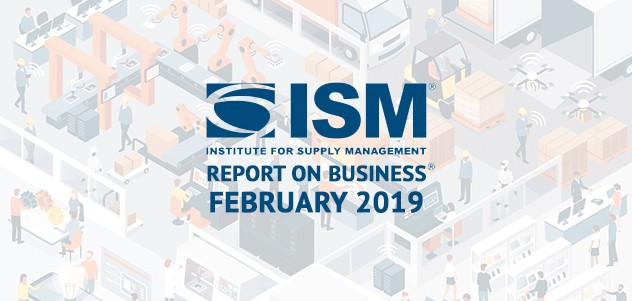The February 2019 Manufacturing ISM® Report On Business® Is a Tale of Two Perspectives

The February 2019 Manufacturing ISM® Report On Business® has arrived, and with it comes a mixed bag of perspectives. The numbers show a continuing cool-off spanning the industry. In defiance of these figures, however, manufacturers’ spirits are up and optimism about the industry is running high. Let’s take a look at both sides of the report, to see how two seemingly opposite sentiments add up to the state of the manufacturing economy today.
The quantitative picture
December 2018 was the lowest point for the Purchasing Manager’s Index (PMI) in more than a year. The report prompted major doubts about the coming 12 months and cast a broad shadow over the manufacturing economy as a whole. However, January’s small recovery appeared to put analysts at ease.
Just a month later, that number is back down again and even lower than December’s. The February PMI registered a 2.4% drop, down to a cumulative 54.2%. The fall was the result of several specific concerns — namely a massive 5.7% drop in production, a tumble of 3.2% in employment, and a drop of 2.7% in new orders.
As a result of these slowing figures, other segments are weathering their own problems. Customers’ inventories are dropping (3.8%), supplier deliveries are trending downward (1.3%), and imports are up (1.5%).
Looking at the pure numbers of the report, there’s not a lot to get excited about. February’s numbers put the PMI at its lowest level of expansion since November 2016.
The qualitative outlook
Looking at the numbers only tells one side of the story from this report. Industry leaders’ statements about the strength of the economy directly contradict the figures. Taking manufacturers at their word means looking at an economy that’s on track and poised for growth.
“Economy showing general strength, especially in manufacturing. Cost pressures and tariff challenges persist but are manageable. General outlook is for stability and potential improvement in the second half of 2019.” (Food, Beverage, & Tobacco Products)
“Orders remain strong. Supplier delivery continues to be challenged on some commodities.” (Machinery)
“Still fairly steady with production and services.” (Transportation Equipment)
Not every sector of the manufacturing economy shares the general optimism. But the collective voice of industry is one of general positivity. It’s easy to understand, based solely on defiance of predictions of economic cool down from as recent as six months ago.

A glimpse at the future
Predicting the future of manufacturing as we head into the second quarter is a fool’s errand. Too many unknown variables hang in the balance — not the least of which is another potential round of tariffs, which rocked the manufacturing economy in 2018. There’s also some trepidation about the numbers, coming from industry voices most impacted by variables such as the lack of skilled workers and the rising cost of goods.
Perhaps the best depiction of the manufacturing economy as a whole right now can be summed up by a quote from the metal fabricated products sector:
“Business so far this year is meeting, but not exceeding, our forecast. We are concerned about indicators showing a slight recession for the second half of the calendar year.”
March will be a crucial indicator for the manufacturing economy. If numbers continue to fall, recession becomes a real threat. If they recover on the heels of a prosperous month, we may be telling a different story.
